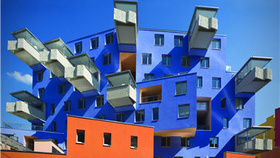Imagine that when you walked in here this evening,
想象一下当你在今晚步入这里时,
you discovered that everybody in the room looked almost exactly the same: ageless, raceless, generically good-looking.
你发现所有在场的人看上去几乎都一模一样,没有年龄和种族的区别,而且个个天生丽质。
That person sitting right next to you might have the most idiosyncratic inner life,
那个坐在你右手边的人,他的内心世界可能极其怪僻,
but you don't have a clue because we're all wearing the same blank expression all the time.
而你却根本看不出来,因为我们始终都是同样面无表情。
That is the kind of creepy transformation that is taking over cities, only it applies to buildings, not people.
这就是正在城市中发生着的诡异转变,只不过不是对公众,而是建筑。
Cities are full of roughness and shadow, texture and color.
城市中遍布粗糙与阴影,但也有和谐与色彩。
You can still find architectural surfaces of great individuality and character in apartment buildings in Riga and Yemen,
你仍然能够在里加和也门这些地区的公寓楼房中找到极具个性的外表设计,
social housing in Vienna, Hopi villages in Arizona, brownstones in New York, wooden houses in San Francisco.
维也纳的社会住房,亚利桑那的霍皮村落,纽约的赤褐色砂石建筑,旧金山的木屋。

These aren't palaces or cathedrals. These are just ordinary residences expressing the ordinary splendor of cities.
它们既不是宫殿,也不是大教堂。它们只是一些展现各自城市魅力的普普通通的住宅房。
And the reason they're like that is that the need for shelter is so bound up with the human desire for beauty.
这些房屋之所以会千奇百丽,正是因为人们生存本能中所附带的对美的追求。
Their rough surfaces give us a touchable city. Right?
那些粗糙的表面带给了我们一个触手可及的城市。对吧?
Streets that you can read by running your fingers over brick and stone.
当你的手指拂过街边的一砖一瓦时,你仿佛走进了小巷深处的记忆。



